|
|
|
Sort Order |
|
|
|
Items / Page
|
|
|
|
|
|
|
| Srl | Item |
| 1 |
ID:
170849
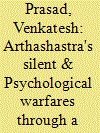

|
|
|
| 2 |
ID:
102216
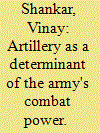

|
|
|
| 3 |
ID:
133045
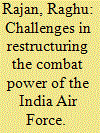

|
|
|
|
|
| Publication |
2014.
|
| Summary/Abstract |
The IAF's capability covers the IOR counties on the maritime side and its principal adversaries Pakistan and China on the landward side
|
|
|
|
|
|
|
|
|
|
|
|
|
|
|
|
| 4 |
ID:
171600
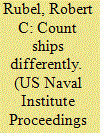

|
|
|
| 5 |
ID:
130879
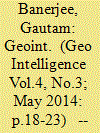

|
|
|
|
|
| Publication |
2014.
|
| Summary/Abstract |
Combat, by its very definition, is an event extra-ordinarily excruciating. It is an ultimate condition that is distinguishable by its phenomenal characteristics which demand, among other undertakings, absolute perfection in marshalling the diverse elements of combat that constitute a military force, for example, troops, firepower, mobility and intelligence. Thus down the ages, 'Great Captains' of war have articulated their strategic intellect to secure victory, irrespective of the bulk of forces, by the best orchestration of the resources under their command. In modern times, developments in 'Information Warfare' have raised the bar of such Terrain intelligence has always been important for winning a battle. In this aricle, the writer advocates establishing a repository of battle-space geographic information called Military Geospatial Intelligence System (MGIS) orchestration to such a high level that it becomes possible to exploit to the hilt the individual capabilities of each element of the military machine. More importantly, it is possible now to seamlessly integrate all such diverse force-elements into one whole system of war-fighting. Military intelligence - terrestrial, strategic and tactical - has always been the most decisive factor in application of combat power as well as an enabling tool for the aforementioned 'best' orchestration of military resources. Within its overall ambit, terrain intelligence - geospatial intelligence in the wider sense as we understand today - has been the pivot of strategic, operational and tactical decision making. In the contemporary period of technological explosion, that pivot has assumed unlimited scope for articulation. At the crosshairs of ever-adversarial forces across terrains of unique descriptions, institution of an efficient mechanism for harnessing the properties of geospatial intelligence - MGIS - must, therefore, be a top priority for India. However, to be really effective, that endeavour has to be tailored to Indian conditions and backed up with indigenous competences; the scope and coverage of GIS as propounded by the lead militaries of the world, USA, China, NATO and Russia, is neither accessible nor sustainable and may not even be necessary in the context of India's technical-industrial-fiscal capacity, and inter alia, her military objectives.
|
|
|
|
|
|
|
|
|
|
|
|
|
|
|
|
| 6 |
ID:
122412
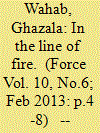

|
|
|
| 7 |
ID:
118721
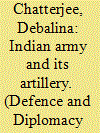

|
|
|
| 8 |
ID:
130346
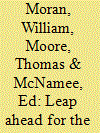

|
|
|
| 9 |
ID:
154423
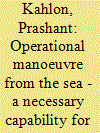

|
|
|
| 10 |
ID:
125925
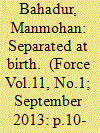

|
|
|
|
|
| Publication |
2013.
|
| Summary/Abstract |
Air-land battle is a term coined by the Americans following their experiences in the Korean and Vietnam wars. They realised that tenets of fighting wars were no longer those based on the World War II model where large ground formations took on the adversary in what were basically variations of the frontal assault and large infantry and tank engagements. With precision guided munitions coming into the inventory from the end of the Vietnam War and technology driven air power getting a bigger say through the capability asymmetry that it introduced, a concept of synergising tactics in conjunction with operational art to generate the desired strategic effects took shape in the form of the air-land battle model.
|
|
|
|
|
|
|
|
|
|
|
|
|
|
|
|
| 11 |
ID:
130881
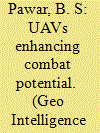

|
|
|
|
|
| Publication |
2014.
|
| Summary/Abstract |
Information is an element of combat power and a combat multiplier in the hands of a commander. Field commanders require an organic, responsive, economically viable, multi- source, long endurance, near real-time reconnaissance capability to collect, process and report intelligence throughout the level of conflict. Additionally, commanders need ability to obtain data from anywhere within enemy territory, day and night (24x7), regardless of weather. The answer lies in the use of UAVs, with their inherent characteristics to provide the flexibility to operate in the extended battle space, thereby enabling the ground forces to see first, understand first, act first and finish decisively. UAVs are remotely piloted or self piloted aircraft that can carry cameras, sensors, communication equipment or other payloads. They have been used in the reconnaissance and intelligence gathering role from 1950s; and more challenging roles are envisaged including combat missions. Unmanned vehicles are not impeded by restraints imposed on manned systems, where both the aircraft and crew could be lost. In fact, they are increasingly being employed for missions that were hitherto the domain of manned aircraft. The UAVs today are also providing exclusive capability to forces engaged in sub-conventional operations, especially in the global war on terrorism - in Afghanistan and Pakistan.
|
|
|
|
|
|
|
|
|
|
|
|
|
|
|
|
| 12 |
ID:
130759
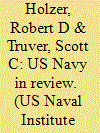

|
|
|
|
|
| Publication |
2014.
|
| Summary/Abstract |
"Over the last year, we were on station in the Pacific to deal with provocative North Korean actions," Chief of Naval Operations Admiral Jonathan Greenert wrote in his foreword to the Navy Program Guide 2014 . "We patrolled off the shores of Syria, Libya, Egypt, Somalia, and Sudan to protect American lives, hunt violent extremists, and induce regional leaders to make constructive choices amid widespread disorder. We delivered aid and relieved suffering in the Philippines in the wake of a devastating typhoon. We mobilized to restrain coercion against our allies and friends in the East and South China Seas. We kept piracy at bay in the Horn of Africa," he continued. "We projected long-range combat power from aircraft carriers in the North Arabian Sea into Afghanistan, and arrayed our forces to enhance stability in the Arabian Gulf. Across the Middle East and Africa, we took the fight to insurgents, terrorists, and their supporting networks by providing high leverage expeditionary support to Special Operations Forces."
|
|
|
|
|
|
|
|
|
|
|
|
|
|
|
|
| 13 |
ID:
130096
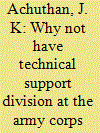

|
|
|
|
|
| Publication |
2014.
|
| Summary/Abstract |
The essence of successful conventional defensive battle is in maintaining elasticity and cohesion; there attar debilitating the enemy's combat power to the danger zone of exhaustion and over- reach, then in launching own counter-offensive alter minimum pause or by use of the 'indirect approach' offensive stratagem to topple/unhinge the enemy's balance and make him reel back, and end up with the destruction of his main force and irrecoverable loss at his territory. This is where the inclusion of TSD at the Corps level will make a great diligence in our calculations. The TSD does not have active Combat Formations under it yet it plays the role at a force multiplier by attentively employing Tactical Reserves and deciding the right timing and objective for such Counter Strike. its main aim and battle extoll is to look deep into enemy territory and discern correctly his pattern of operations almost to a predictable certainty.
|
|
|
|
|
|
|
|
|
|
|
|
|
|
|
|
|
|
|
|
|